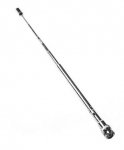Hi Folks,
I'm new to antennas. I have a GRE PSR800 scanner. I just received a generic telescopic, 7 element, 6.5-24.5" (including BNC) elbow join antenna. According to technical data, this is supposed to cover between
20-1800MHz.
As I was trying to figure out what elements/lengths to use for which frequency ranges, I ran into this site which provides an Antenna Length Calculator.
Based on the calculator, the optimal length for say, 862MHz would be 3.25". Now the lowest I can fold my antenna to is 6.5", so I'm aware that I can not get the optimal reception. But when I extend the antenna to it's full length, I actually noticed that I'm able to gain an additional signal bar with less static for the 800MHz range...
So the results I obtained are inverse-proportional to the calculator data, hence my dilemma... do telescopic antennas follow a different method of calculation? How would I know what element extension to use for each frequency range for this antenna?
Thx in advance
I'm new to antennas. I have a GRE PSR800 scanner. I just received a generic telescopic, 7 element, 6.5-24.5" (including BNC) elbow join antenna. According to technical data, this is supposed to cover between
20-1800MHz.
As I was trying to figure out what elements/lengths to use for which frequency ranges, I ran into this site which provides an Antenna Length Calculator.
Based on the calculator, the optimal length for say, 862MHz would be 3.25". Now the lowest I can fold my antenna to is 6.5", so I'm aware that I can not get the optimal reception. But when I extend the antenna to it's full length, I actually noticed that I'm able to gain an additional signal bar with less static for the 800MHz range...
So the results I obtained are inverse-proportional to the calculator data, hence my dilemma... do telescopic antennas follow a different method of calculation? How would I know what element extension to use for each frequency range for this antenna?
Thx in advance
Attachments
Last edited:


